22 Real-Life Examples of Helpful Answers to Customer Q&A

Oftentimes, shoppers have questions standing in the way of a purchase decision. This is true regardless of whether the consumer is shopping online or at a physical store location.
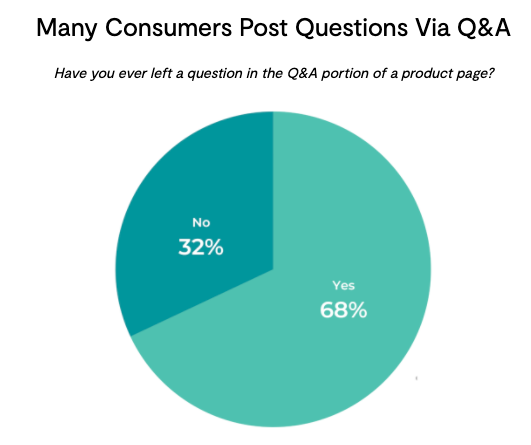 Of course, if a consumer is shopping in-store and has an unanswered question, they can find the nearest sales associate to get an answer. But online shoppers don’t have that luxury. And that can be a big problem. After all, research from Forrester tells us that over half of shoppers are likely to abandon an online purchase if they can’t find a quick answer to their question.
Of course, if a consumer is shopping in-store and has an unanswered question, they can find the nearest sales associate to get an answer. But online shoppers don’t have that luxury. And that can be a big problem. After all, research from Forrester tells us that over half of shoppers are likely to abandon an online purchase if they can’t find a quick answer to their question.
A growing number of brands are adding Questions and Answers (Q&A) software to their product pages to empower consumers to pose their purchase-blocking questions when shopping online. And a lot of shoppers are using this feature. Per a recent report from PowerReviews, 68% of consumers have left a question in the Q&A portion of a product page.
Brands Must Respond Quickly to Customer Questions Submitted via Q&A
The best brands also make it a priority to provide fast, accurate answers to the questions posed via customer Q&A. Doing so boosts the confidence of the shopper who posed the question — and increases the likelihood they’ll convert. What’s more, a brand answer will help future shoppers who browse Q&A before purchasing a product or service. And a lot of consumers do so. A PowerReviews survey found that 72% of shoppers read Q&A regularly or always when it’s available. What’s more, according to data from Bazaarvoice, brands can experience a 98% lift in conversion when they respond to questions via Q&A.
When it comes to responding to questions posed via customer Q&A, time is of the essence. If you take too long to respond, the shopper is likely to get distracted and look elsewhere. On the other hand, providing a quick answer is an opportunity to delight customers and create a competitive advantage.
So, how fast is fast enough? Ideally, customers should get answers to their questions in real-time. That might seem like a pipe dream if customers submit questions through multiple sites, such as your own dot come, retailer sites and Amazon. But if you’re a Reputation Studio customer, real-time responses can be a reality. That’s because Reputation Studio from 1440 allows you to manage all Q&A from a single platform. You get alerted when a new question comes in — and your team can provide a fast, accurate and helpful answer that delights the shopper and increases the likelihood of them making a purchase.
11 Types of Helpful Answers to Customer Questions Posed Via Q&A
Timely, helpful answers enable shoppers to make better purchase decisions. Read on to explore 11 types of helpful answers to customer questions submitted via Q&A — along with 22 real-life examples.
1. Answers to Use Questions
Sometimes, customers will have questions about how to use a particular product. For example, this consumer is shopping for a set of skincare products and wants to know what time of the day to use them.
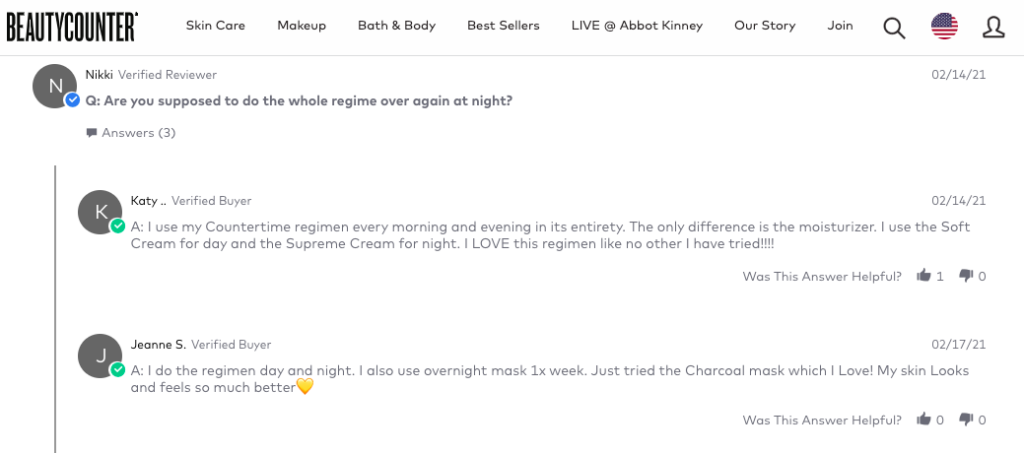
Providing a quick, accurate answer ensures the shopper will use the product correctly. And that means they’re more likely to have optimal results. When they do, they’re likely to purchase again — and tell others about their great experience.
2. Answers to Compatibility Questions
Some shoppers will pose questions to determine whether a product they’re considering will work with something they already own. For example, this shopper wants to know if a dresser from Room & Board will coordinate with a bed she already owns from the same brand.

And this customer wants to know if a special type of TV is required to use an Amazon Fire Stick.

Answer compatibility questions quickly. If you don’t, consumers probably won’t go through with the purchase. Or, they might end up purchasing products that don’t work with what they already own. The result? Dissatisfied shoppers who are likely to return those incompatible products.
3. Answers to Ingredients Questions
Questions about ingredients are common for food and beverage products, as well as skincare and cosmetics. Typically, consumers pose these questions because they’re trying to avoid certain ingredients, perhaps due to allergies, a sensitivity or even just personal preference.
For example, this consumer shopping for face cream posted a question asking if a particular product contains peanuts, tree nuts or sesame.

Make it a priority to respond to questions about ingredients ASAP. If you don’t, someone might purchase a product that ends up causing health or safety concerns — for example, a serious allergic reaction. This not only harms the customer, it also can damage your hard-earned reputation.
4. Answers to Materials Questions
A shopper might have an outstanding question about what types of materials were used to make a given product. Similar to ingredients questions, materials questions are posed for a number of different reasons, including allergies, sensitivities or personal preferences.
For example, this shopper posted a question to ask what kind of materials were used to make a t-shirt. This might be because her skin is sensitive to certain types of materials — or maybe she just prefers the feel of one material over another.
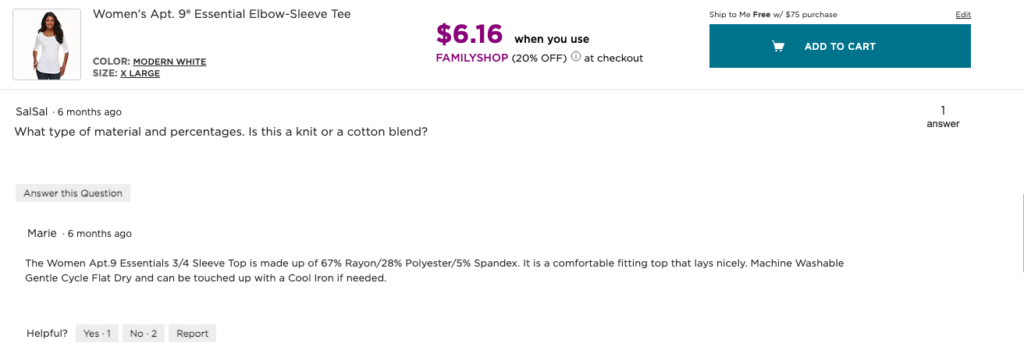
This consumer is weighing her hairbrush options. But she wants to be sure the bristles are synthetic because she is a vegan.

And finally, before making a purchase, this shopper asked a question to ensure a baby teether is free of heavy metals — likely because of health and safety concerns.
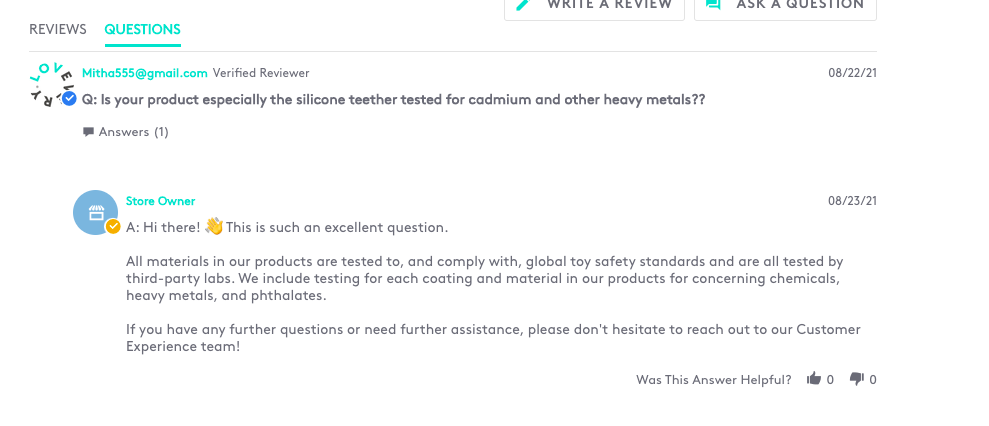
Providing quick answers to materials questions helps shoppers more easily identify the products that’ll fit their unique needs. And that means they’re more likely to be satisfied when their items arrive in the mail.
5. Answers to Origin Questions
According to a U.S. News & World Report article, about three-quarters of consumers say that where a product was made impacts their preference to purchase it. And 71% of American consumers are willing to spend more on products made in the U.S.
If a product description doesn’t make it clear where a product was made, a consumer may ask via Q&A. For example, this consumer posted a question to ask where a chair was made.
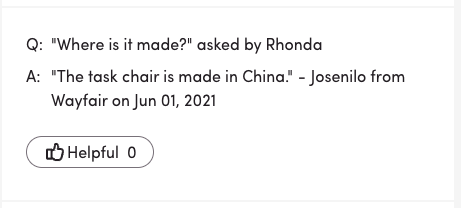
And this shopper posted a similar question about a lawnmower.
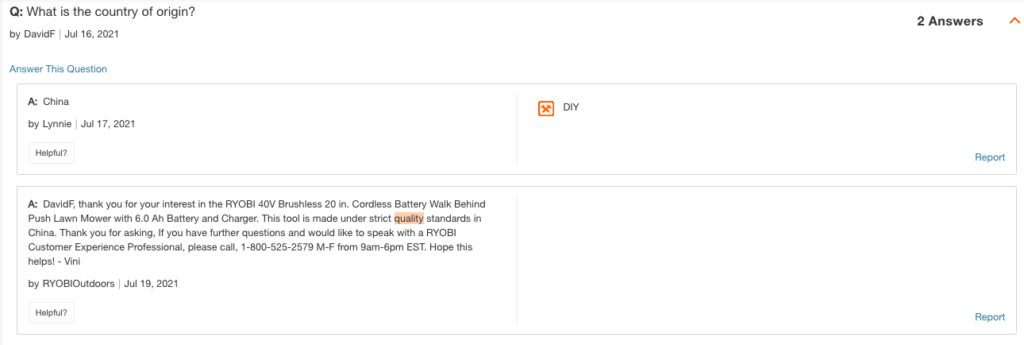
Be sure to respond to these types of questions as quickly as possible. In addition to providing the country of origin, consider providing more details on the manufacturing process. For example, in the lawnmower example, the brand explains that the product is “made under strict quality standards…”
6. Answers to Contents Questions
When a consumer is shopping online, it can be tough to determine what is (and isn’t) included with a purchase. For example, if a shopper is renovating their bathroom and looking for a new toilet online, they might not know for certain what will be included in the box — and what they’ll need to buy separately. So, they might do what this shopper did, and post a question to ask whether the product comes with both the wax ring and the toilet seat.
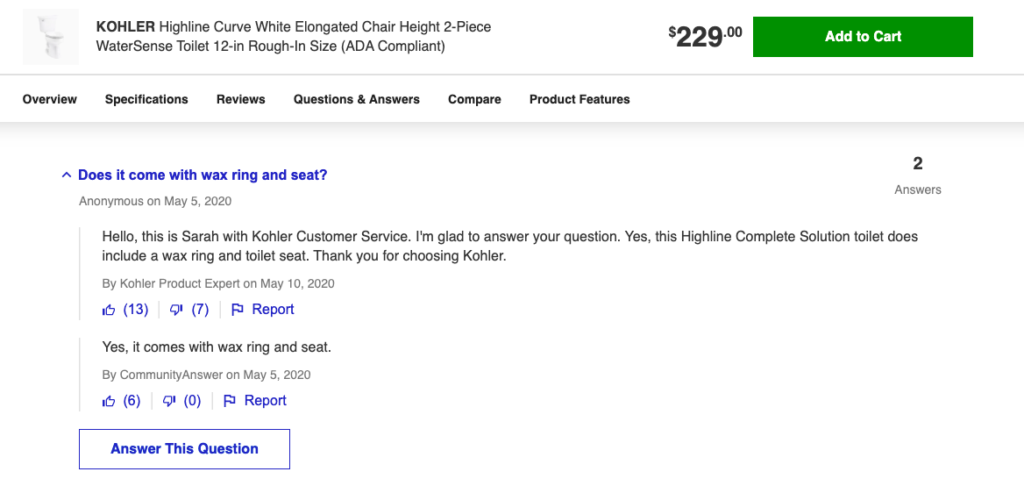
Respond quickly. A shopper will be disgruntled if they expect something to be included in a purchase and it’s not. This could lead to returned merchandise, a negative review, and the shopper avoiding your brand in the future.
7. Answers to Product Comparison Questions
Oftentimes, a shopper weighs multiple, similar options before making a purchase decision. In such cases, they may submit a question to better understand the differences between two (or more) options so they can pick the one that best fits their needs.
For example, this shopper is asking about the differences between two different eyebrow gels.
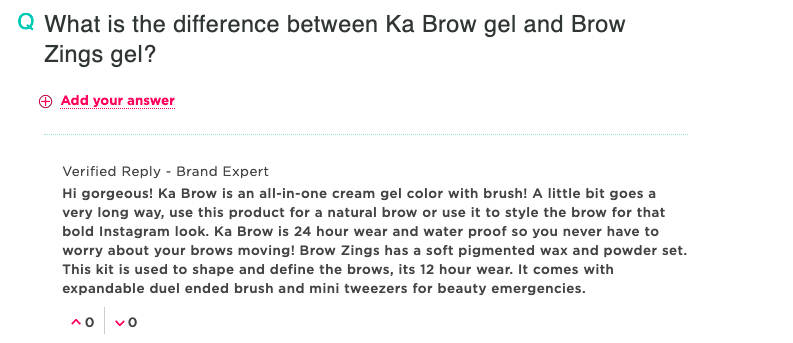
And this shopper wants to understand the key differences between three different car seat models.
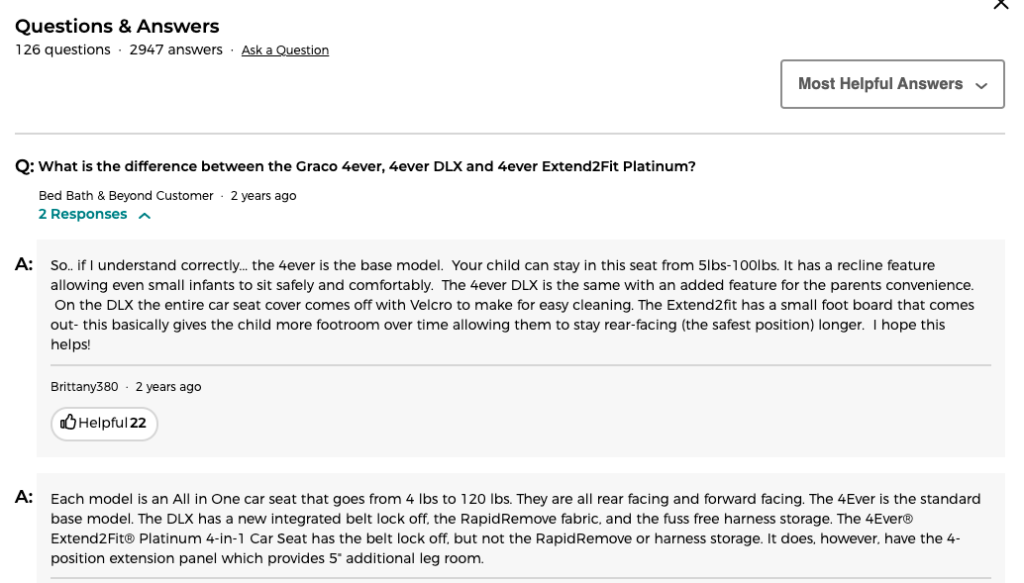
Finally, this consumer wants to get a better understanding of the primary differences between an older version of a product and a newer one.
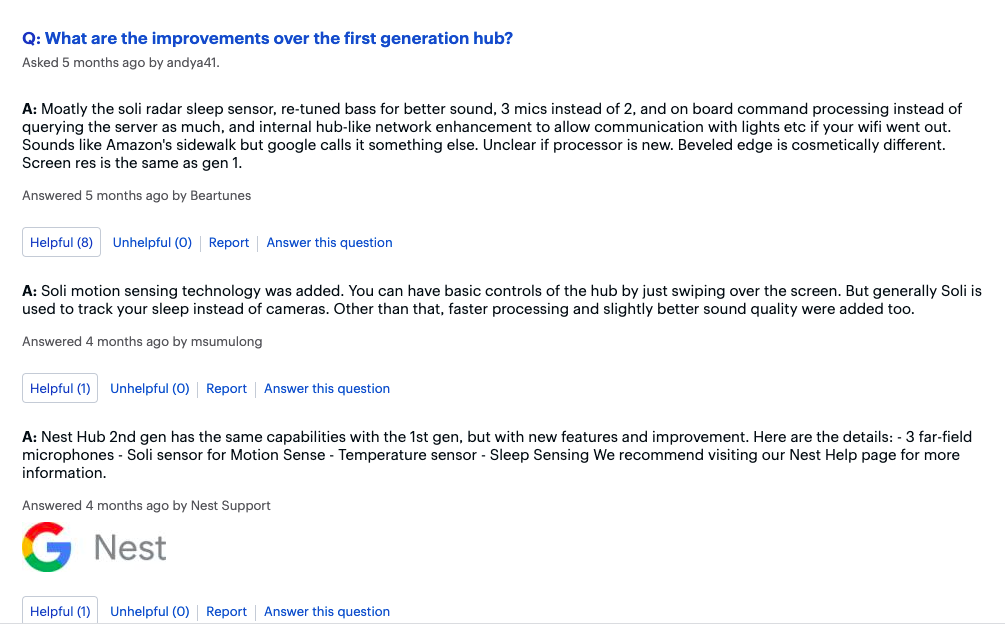
When shopping online, it can be difficult for consumers to determine which of their options will best fit their needs. By providing speedy responses to product comparison questions, you’re helping shoppers make better purchasing decisions.
7. Answers to Specific Feature Questions
You might have the most thorough product descriptions. But a potential customer might still have an outstanding question about a specific feature of a product. For example, this shopper wants to know whether a ceiling fan comes with a remote control.
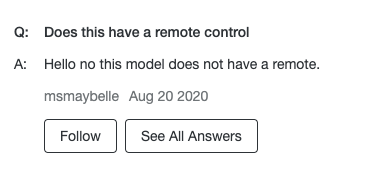
Responding quickly ensures shoppers have a full understanding of the features that matter most to them. Then, they can decide if the product fits their needs.
8. Answers to Sizing Questions
When a consumer is shopping for clothing or shoes in a brick-and-mortar store, they can try on items to ensure they’re a good fit. Of course, this isn’t possible when shopping online — and it can cause problems. Per a Shopify Plus article, 52% of fashion merchandise is returned because it’s either too big or too small.
Today, most eCommerce sites selling apparel have size charts and other tools to help shoppers choose the right size. However, some customers may still have questions about sizing.
Take, for example, this mother posted a question about what size shoe to buy for her son.

As another example, this shopper is asking for advice on what size to buy in a certain style of shoe — based on her size in another style.
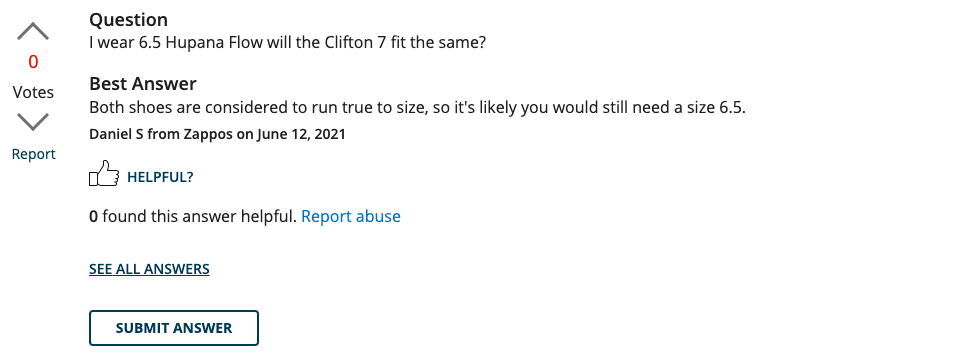
And this shopper is asking for feedback on finding the right bra size, based on the measurements she took of herself.

Speedy responses to sizing questions help shoppers pick the right size. Then, the item is more likely to fit correctly — and the shopper will be less likely to return it.
9. Answers to Quality and Longevity Questions
Of course, all consumers want to buy items that are of good quality and stand the test of time. But quality is something that’s difficult (if not impossible) to assess while shopping online. So, some shoppers will ask questions via Q&A to get a better understanding of the quality of a product.
For example, this shopper posed a question on Amazon to ask about the quality of the wood used in a baby crib.

And this consumer asked a question about the quality of a coffee maker they’re considering.

Getting a quick answer to a quality question can boost shopper confidence — and the chances that they’ll purchase the product. While brand responses are powerful, some brand and retailer sites (including Amazon) also allow shopper questions like these to be answered by other customers who have already purchased the product in question. That can go a long way, as consumers appreciate hearing feedback from others like them.
10. Answers to Logistics Questions
Oftentimes, shoppers will post questions via Q&A about a product. But there will also be times when you’ll get questions unrelated to the product, but rather about policies and procedures — such as shipping and returns.
For example, this shopper posted a question to ask how much it would cost to ship a specific toy to Dubai.
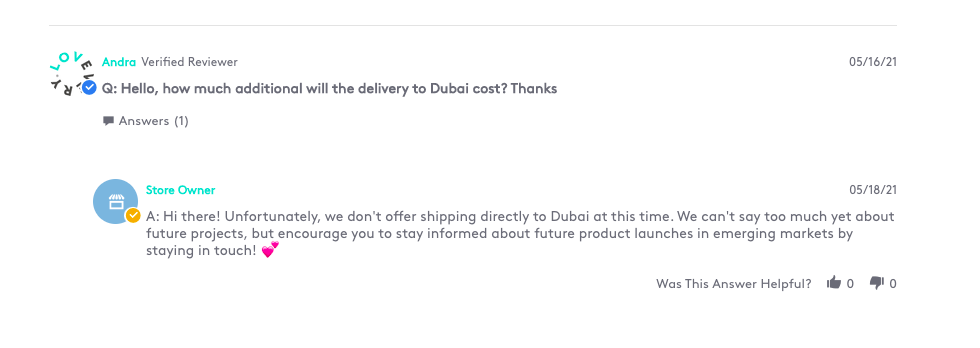
And before committing to a purchase, this shopper wants to know if shipping costs will be refunded if they decide to return the product.

Consumers weigh many factors — including shipping and returns — when deciding whether or not to purchase a product. So be sure to provide a helpful answer to any logistical questions submitted via Q&A.
11. Damage or Defects Questions
Most often, customers post questions via Q&A before they make a purchase decision. But in some cases, a shopper will post a question after making a purchase. For instance, they might post questions about damaged or defective products. Take, for example, this question from a shopper about a problem with their brand new washing machine.
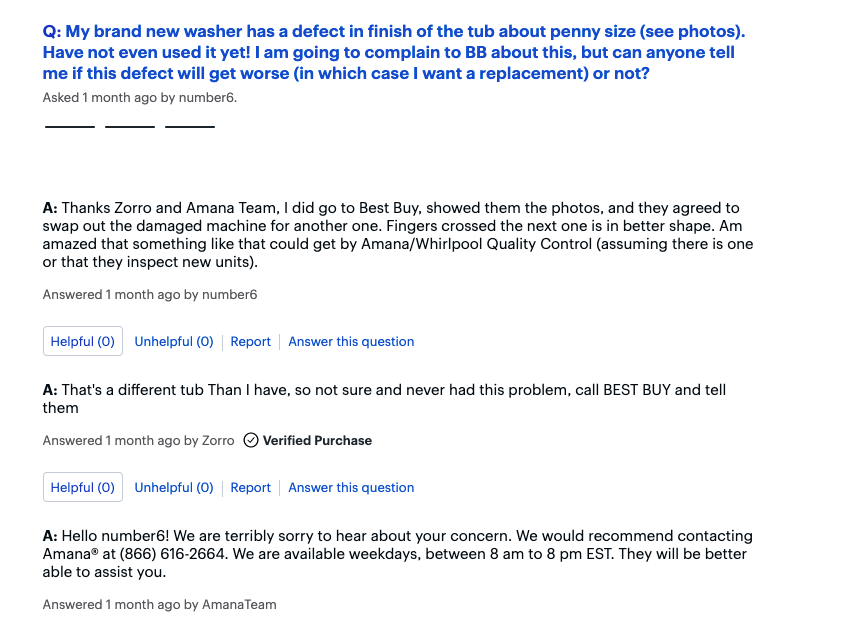
A timely response to a post-purchase question — such as one related to a damaged or defective product — can help you turn a negative situation around and win back the trust of a customer. What’s more, future shoppers will see your answer to the customer’s question, which will show them you’re a brand that stands by its products and is committed to making things right for your customers.
Start Providing More Helpful Responses to Customer Q&A — Quickly
Increasingly, consumers turn to the Q&A section of product pages to overcome uncertainty and find the products that best fit their needs. Brands and retailers must make it a priority to effectively manage Q&A across channels. This includes providing fast (ideally, in real-time), accurate answers to customer support and product questions posed via Q&A.
Find out how Reputation Studio by 1440 can help you manage all Q&A from a single platform so you can provide quick answers that delight your shoppers. Request a live demo today.